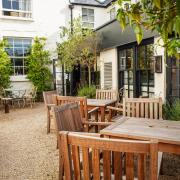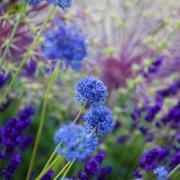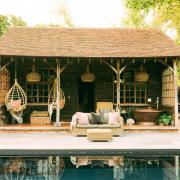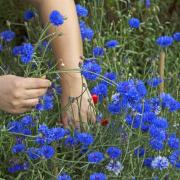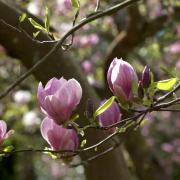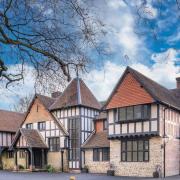These English Garden beauties are part of our summer landscape. Take a wander through Hampshire’s open gardens in June and you’re sure to see a selection to inspire for your own outdoors.
Whether entwining with clematis around an arbour, mixed in an herbaceous border, or sprawling over a fence, roses set the mood for romance with their classic look.
Sales of Britain’s favourite flower however have declined, and a campaign started last year is aiming to encourage more roses to be planted and appreciated for their versatility.

You may like to create your vignettes as one-off showy scenes for a summer highlight or use repeat-flowering blooms or colourful hips to extend the seasonal combinations.
Roses are versatile for both formal and informal styles, making them a gorgeous addition to any garden. It’s easy to be beguiled by the vast array on offer, but by doing your research and selecting good quality disease-resistant varieties that will suit your conditions you will have the most success.
Visiting gardens where you can see the mature plant in a range of situations and combinations, especially if local to you with similar conditions, is the best way to decide what roses you like and what will suit your own space.
Getting to know the three main categories of roses will help you identify types of roses and aid your decision making process. Wild or species roses like to sprawl in a natural style, are mostly single-flowered, and many have colourful hips in autumn, such as rugosa, glauca, moyesii and canina.

Old garden roses are ones from before 1860 and are characterised by large, graceful shrubs with mostly one flowering, are richly fragrant and include alba, gallica, damask, cabbage and moss roses.
Modern roses bred from the early 20th century have characteristics of repeat-flowering and a striving for disease resistance, vigour and flower quality. These cover hybrid teas, floribundas, landscape, climbers, miniature and David Austin English roses.
To add a little confusion - the diverse and versatile shrub roses don’t fit any distinct classification. They can be wild rose species and also sports and hybrids, taking the best of the old, combined with modern traits of repeat-flowering and diversity of form, colour and fragrance.

One of our county’s most famous rose gardens has to be the National Trust’s Mottisfont with it’s glorious vision of massed old roses. The walled garden is home to the National Collection of pre-1900 old-fashioned roses, which flower only once so try to time your visit at the peak of bloom in June. There are even extended hours until 8pm on Thursdays, Fridays and Saturdays to enjoy the 500 varieties as the scent rises in the evening, filling the air.
You will discover roses you’ve not seen before, ways to combine them with perennials and how to display them to perfection on arbours. You will also note that after flowering they are not deadheaded, but rather allowed to form glossy hips for wildlife and colour in autumn.

On a smaller scale but also glorious are the roses at Durmast House, a restored Gertrude Jekyll designed garden in the New Forest and open by arrangement through the National Garden Scheme. Along with characteristic colour-themed borders there is a large rose garden in the shape of two halves of a diamond and edged in Munstead lavender. Here you’ll be able to admire roses, many of them rare French roses, in every shade of pink and come under the spell of roses en masse as the stars of the show, as well as mingling through borders and cascading over supports.
I also love the roses through the charming gardens at Houghton Lodge – from a tunnel of blooms, through fragrances to entice by the tea room terrace, near the tactile herb garden and against a protected wall. Here they are part of the summer landscape and used in a range of ways to suit the historic country idyll. As you wander any of these gardens, do ask questions if the owner or gardeners are around. Enquire about hardiness, combinations and maintenance tips of the roses you are drawn to.

Aim to order now or buy from your local garden centre or a specialist grower, such as Pococks Roses of Romsey who grow a selection of the best garden roses in their fields. Container-grown roses can be planted year round except when the soil is frozen, water logged, or in drought. Late autumn is a great time to plant bare-root roses, the most economical option, but don’t plant when the ground is frozen in mid-winter, and you can also plant late winter to early spring. Roses are sun-loving plants, benefitting from six to eight hours of sun a day. They like well-drained soil that still holds moisture long enough for the roots to absorb. Choosing wisely for the situation, following the care needed, providing air circulation to avoid mildew, and using good hygiene and husbandry practises, such as clean secateurs for pruning and removing fallen leaves, helps avoid many issues that can afflict roses.
Where to see rose displays in Hampshire
Mottisfont Abbey, Romsey, Hampshire, SO51 0LP
Walled rose garden with one of the best old rose National Collections
nationaltrust.org.uk/mottisfont
Durmast house, Burley, BH24 4AT
NGS: Open June 25 (2-5pm)
Visitors also welcome by arrangement Apr 1 – Aug, groups 1-99
ngs.org.uk
Houghton Lodge Gardens, Houghton, SO20 6LQ
Gardens open daily April to end Sept (10am-5pm)
houghtonlodge.co.uk
Pococks Roses, Romsey, SO51 0QA
Open Monday to Saturday
garden-roses.co.uk
Top tips
Choose a good sunny, open position.
Select your varieties carefully that will be the right size and are naturally disease resistant.
If you want a fragrant rose garden, experience the scents first hand if you can.
Fertilise in spring and summer, water as needed and prune in late winter.
Roses look lovely mixed with other plants but keep them away from the base to allow air circulation.






